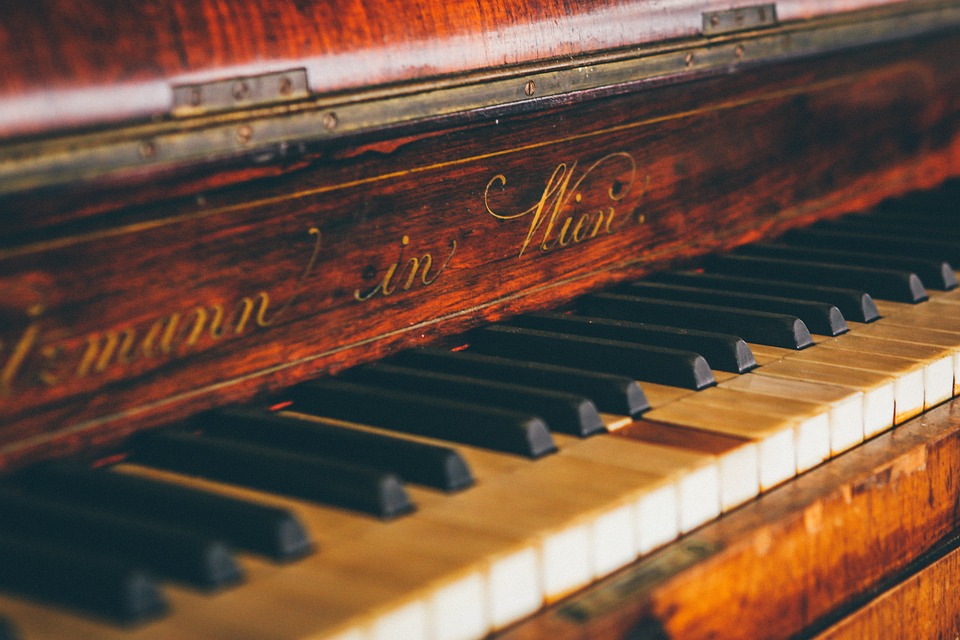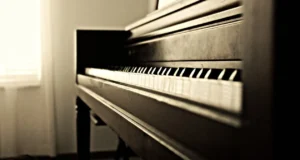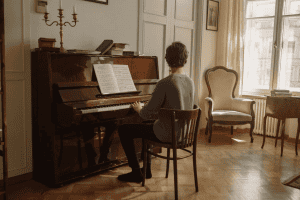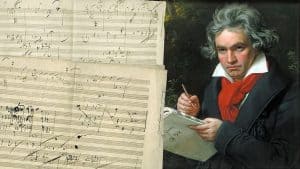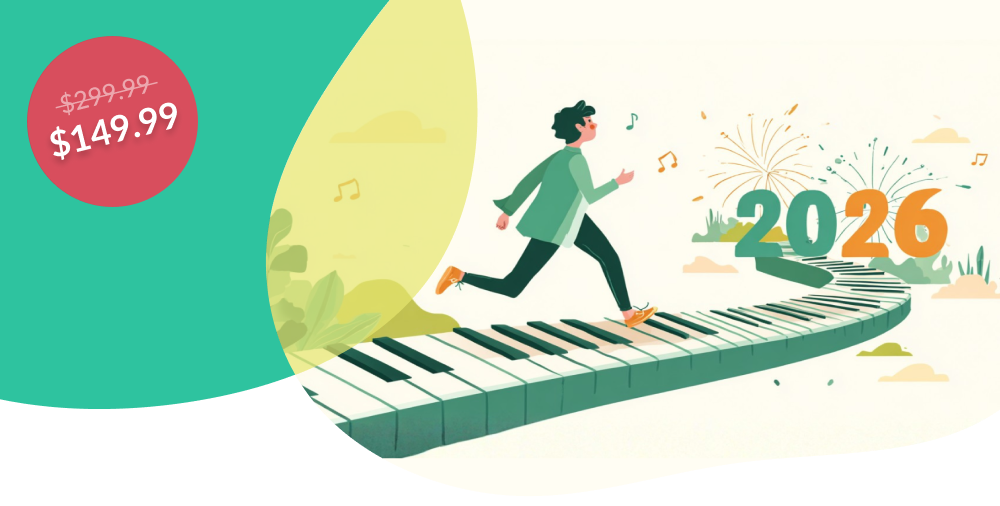For many fans, the music from anime shows holds a special and important place in their hearts. The emotional depth, catchy melodies, and musical timbres often make anime songs not only pleasing to hear, but fun and exciting to play on the piano.
One of the best aspects of anime music is its ability to express a wide range of emotions, from action to intimacy to heartbreak and joy. Many of these songs have become deeply associated with key moments in stories, making them uniquely meaningful.
Learning how to play famous anime songs on piano is a richly rewarding experience. In this article, we will explore some of the best anime songs to learn on piano and discover some tips and strategies you can use to practice today!
- Fall in love with the music - Learn your favorite songs, at a level suitable for you.
- Enjoy interactive piano lessons - Explore courses covering music theory, technique chords & more.
- Get real-time feedback - Skoove's feedback tells you what went well and what needs practice.

Why learn anime songs on piano?
Anime songs are a unique blend of different musical genres, ranging from pop and rock to classical and jazz. This diversity makes them a valuable addition to any pianist’s repertoire. Let’s explore a few reasons why you should consider learning and adding some easy piano songs from anime to your repertoire.
Emotional connection and nostalgia
Many anime songs evoke strong emotions and memories. Playing these songs on the piano can bring back those feelings and create a deep connection with the music.
For example, playing “One Summer’s Day” from Spirited Away can transport you back to the enchanting world of the film, while “Unravel” from Tokyo Ghoul might evoke the intense emotions of the series.
Musical diversity and complexity
Anime music often incorporates complex arrangements and diverse musical elements. This can help improve your technical skills and introduce you to new playing styles.
For instance, the intricate fingerwork required for “Tank!” from Cowboy Bebop can improve your dexterity, while the sweeping melodies of “My Dearest” from Guilty Crown can help you develop expressive playing.
Enhancing piano skills
The varied tempos, rhythms, and dynamics found in anime songs can challenge you to develop better finger coordination, timing, and expressive playing.
Learning to play these songs can enhance your overall musicianship and make you a more versatile pianist. For example, the dynamic contrasts in “Again” from Fullmetal Alchemist: Brotherhood can help you practice playing both softly and powerfully, while the rhythmic complexity of “Guren no Yumiya” from Attack on Titan can improve your sense of timing.
Cultural enrichment
Learning anime songs on the piano can also deepen your appreciation for Japanese culture and music. Many anime soundtracks are influenced by traditional Japanese music, and playing these songs can give you a better understanding of these cultural elements.
For instance, the use of pentatonic scales and traditional instruments in some anime soundtracks can introduce you to new musical concepts.
Community and social engagement
Playing anime songs can also be a great way to connect with other anime fans and musicians. Sharing your performances on social media or at anime conventions can lead to new friendships and collaborations.
Additionally, there are many online communities and forums dedicated to anime music where you can find sheet music, tutorials, and advice from other pianists.
Top 10 best anime piano songs
Anime music offers a treasure trove of beautiful and iconic songs that are perfect for the piano. Let’s explore 10 of the best anime piano songs so you have some ideas for where to start with this project. Most of these songs are relatively simple, but have their challenging moments like many of the hardest piano songs. They are well suited to intermediate to advanced pianists, but you can likely find simplified versions.
1. “Again” by Yui (Fullmetal Alchemist)
“Again” is the opening theme for the anime Fullmetal Alchemist: Brotherhood. Sung by Yui, this song captures the intensity and emotion of the series. The song’s lyrics reflect the themes of determination and struggle central to the anime’s story.
The song’s dynamic range and powerful melody make it a compelling piece to play, with both energetic and softer sections that challenge your expressive playing. The song’s structure, which alternates between calm verses and powerful choruses, can help you practice dynamic contrast and emotional expression.
2. “Unravel” by TK (Tokyo Ghoul)
“Unravel” is the hauntingly beautiful opening theme for Tokyo Ghoul. Sung by TK from Ling Tosite Sigure, the song is known for its emotional depth and intricate composition. The song’s lyrics and melody capture the protagonist’s internal struggle and transformation.
“Unravel” features rapid fingerwork and dramatic dynamics, making it a great piece for improving your technical skills and emotional expression. The song’s complex harmonies and fast tempo can challenge your finger coordination and dexterity.
3. “Blue Bird” by Ikimono Gakari (Naruto Shippuden)
“Blue Bird” is one of the most popular opening themes from Naruto Shippuden, performed by the band Ikimono Gakari. The song is upbeat and energetic, reflecting the adventurous spirit of the series.
The song’s upbeat tempo and catchy melody make it a fun and energetic piece to play, perfect for practicing rhythm and coordination. The song’s repetitive motifs and rhythmic drive can help you develop a strong sense of timing and pulse.
4. “Guren no Yumiya” by Linked Horizon (Attack on Titan)
This powerful opening theme from Attack on Titan is known for its epic and grandiose sound. The song captures the intense and dramatic atmosphere of the anime, with lyrics that speak to themes of struggle and resistance.
The intense and dramatic composition of “Guren no Yumiya” provides an exciting challenge for pianists, with its fast tempo and powerful chords. The song’s rhythmic complexity and driving tempo can help you develop a sense of urgency and intensity in your playing.
5. “Howl’s Moving Castle Theme” by Joe Hisaishi
Composed by Joe Hisaishi, the theme from “Howl’s Moving Castle” is a beautiful and enchanting piece that captures the magic of the film. The piece is known for its lyrical melody and rich harmonies.
The soothing and melodic nature of this piece makes it perfect for practicing lyrical playing and developing a gentle touch. The song’s flowing melodies and lush harmonies can help you practice smooth, legato playing and dynamic control.
6. “Sadness and Sorrow” by Toshio Masuda (Naruto)
“Sadness and Sorrow” is a poignant and emotional piece from the Naruto soundtrack, often used in the series’ most touching moments. The piece is known for its simple, yet deeply moving melody.
The slow and expressive melody is ideal for practicing dynamics and emotional interpretation. The song’s simple structure and emotional depth can help you focus on expressive playing and developing a sensitive touch.
7. “Tank!” by Yoko Kanno (Cowboy Bebop)
“Tank!” is the iconic opening theme for Cowboy Bebop, composed by Yoko Kanno and performed by the Seatbelts. The song is a high-energy jazz piece that captures the cool, stylish atmosphere of the anime.
The jazzy and energetic style of “Tank!” makes it a unique and fun piece to play, great for improving rhythm and finger dexterity. The song’s fast tempo and intricate rhythms can challenge your timing and coordination.
8. “My Dearest” by Supercell (Guilty Crown)
“My Dearest” is the opening theme for Guilty Crown, performed by the music group Supercell. The song is known for its dramatic and emotional melody, which reflects the intense emotions of the series.
The song’s dramatic and sweeping melody provides a wonderful opportunity to practice expressive playing and dynamic contrasts. The song’s rich harmonies and powerful choruses can help you develop a strong sense of musical expression.
9. “One Summer’s Day” by Joe Hisaishi (Spirited Away)
Another masterpiece by Joe Hisaishi, “One Summer’s Day,” is the main theme from the beloved film Spirited Away. The piece is known for its gentle, flowing melody and soothing harmonies.
The gentle and flowing melody is perfect for practicing legato playing and developing a smooth touch. The song’s lyrical quality and simple structure can help you focus on expressive playing and developing a gentle touch.
10. “Clannad Theme” by Jun Maeda
The theme from “Clannad” is a beautifully emotional piece composed by Jun Maeda, known for its heartwarming and nostalgic feel. The piece captures the emotional depth and poignancy of the series.
The delicate and expressive nature of this piece makes it ideal for honing your emotional interpretation and dynamic control. The song’s simple, yet deeply moving melody can help you focus on expressive playing and developing a sensitive touch.
Tips for learning anime songs on piano
Learning anime songs on piano can be a rewarding experience, but it can also come with its own set of challenges. Let’s explore some tips and strategies you can use to learn anime piano songs, or any of the best piano songs for that matter.
| Regular practice routines | Consistency is key. Set aside dedicated practice time each day to work on your chosen anime songs. Even short, regular practice sessions can lead to significant improvements over time. Establishing a routine can help you stay motivated and make steady progress as you learn how to play piano. |
| Breaking down difficult sections | If you encounter a challenging part in a song, break it down into smaller sections. Practice each section slowly and gradually increase the tempo as you become more comfortable. Focusing on smaller sections can make the learning process more manageable and less overwhelming. |
| Playing along with original anime tracks | Listening to the original anime tracks while practicing can help you get a better feel for the rhythm and dynamics of the song. It can also make your practice sessions more enjoyable and immersive. Playing along with the original track can help you match the tempo and phrasing more accurately. |
| Recording and reviewing your practice sessions | Recording yourself while practicing can provide valuable feedback. Listen to the recordings to identify areas that need improvement and track your progress over time. Reviewing your recordings can help you pinpoint specific areas to focus on and celebrate your progress. |
| Using sheet music and tutorials | Utilize sheet music and online tutorials to guide your practice. These resources can provide visual and auditory guidance, making it easier to learn the songs accurately. Sheet music can help you understand the structure and details of the piece, while tutorials can provide additional tips and techniques. |
| Patience and persistence | Learning complex pieces takes time and effort. Be patient with yourself and persist through difficult sections. Celebrate small victories along the way to stay motivated. Remember that progress may be slow at times, but with consistent effort, you will improve. |
| Practicing with a metronome | Using a metronome can help you develop a strong sense of timing and rhythm. Start practicing at a slower tempo and gradually increase the speed as you become more comfortable with the piece. This can help you maintain a steady tempo and improve your overall timing. |
| Focusing on dynamics and expression | Pay attention to the dynamics and expressive markings in the sheet music. Practicing these elements can help you bring out the emotional depth of the piece and make your performance more engaging. Experiment with different levels of volume and phrasing to find the most expressive interpretation. |
Check out this medley video by PACIL, playing a compilation of 50 anime sounds on piano in a span of five minutes only. You can consider the hand movements and apply the same when practicing for your favorite pieces.
Enjoy learning anime music!
Learning anime songs on the piano, or any music from film, television, or video games, is a fun and rewarding experience. You can learn so much from practicing piano themes from popular shows and movies, including enhancing your technique, musicality, and expressive capabilities.
Platforms like Skoove make the learning process even more enjoyable and efficient, offering interactive lessons and real-time feedback. So why wait? Start your journey today by exploring some of the best anime piano songs and see how Skoove can help you along the way.
Author of this blog post:
Susana Pérez Posada

With over seven years of piano education and a deep passion for music therapy, Susana brings a unique blend of expertise to Skoove. A graduate in Music Therapy from SRH Hochschule Heidelberg and an experienced classical pianist from Universidad EAFIT, she infuses her teaching with a holistic approach that transcends traditional piano lessons. Susana’s writings for Skoove combine her rich musical knowledge with engaging storytelling, enriching the learning experience for pianists of all levels. Away from the piano, she loves exploring new places and immersing herself in a good book, believing these diverse experiences enhance her creative teaching style.
Published by Lydia Hovan from the Skoove team







